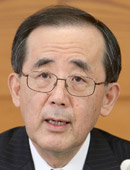Bank of Japan to be a house divided

Clockwise from left: Haruhiko Kuroda(68)-Governor(former president of Asia Development Bank), Kikuo Iwata(70)-Deputy governor(former Gakushuin University professor), Ryuzo Miyao(48)-Policy board member(Kobe University professor), Sayuri Shirai(50)-Policy board member(Keio University professor), Hiroshi Nakaso(59)-Deputy governor(Assistant governor at BOJ), Takehiro Sato(51)-Policy board member(former executive at Sumitomo Bank), Takahide Kiuchi(49)-Policy board member(former No-mura Securities chief economist), Koji Ishida(65)-Policy board member(former president of Sumitomo Bank),Yoshihisa Morimoto(70)-Policy board member(former executive of Tokyo Electric Power Corp)
The three members officially started their monetary policy board positions yesterday after approval by parliament last Friday.
“It’s an unprecedented philosophical shift,” Ysaunari Ueno, chief market economist at Mizuho Securities, was quoted as saying in a recent interview with the Financial Times, hinting that BOJ’s policy will shift to ending deflation from monetary policy centered on economy and financial reform.

A philosophical shift signals a possible clash in BOJ’s monetary policy board as some of six old board members oppose the new leadership’s aggressive monetary policy.
Already, two of them, Takahide Kiuchi, former Nomura Securities chief economist, and Takehiro Sato, former executive at Sumitomo Bank, are regarded as opponents to implementing a looser monetary policy.
The two men, who are lukewarm about quantitative easing, have opposed raising the inflation target to 2 percent from 1 percent saying they are “very high” in a monetary policy board meeting in February.
They said BOJ’s No.1 priority is to address government debt that’s now more than double Japan’s gross domestic product.
Revamping the economy has been the core paradigm of the BOJ for the past 23 years. The paradigm was first mapped out by Yasushi Mieno, former BOJ governor, who successfully ended bubbles surrounding the Japanese economy by deliberately tightening money and raising interest rates.
“To revamp economy and fiscal condition, we have to endure sacrifice [deflation],” Mieno said in February 1990. “If we slacken the rein of austerity measures, this will taper off our will for reform.”
Given that policies driven by Mieno have continued for more than 20 years, market observers suggest some BOJ monetary policy board members who are known to be moderate may not fully support aggressive monetary easing championed by the new Kuroda leadership.
Yoshihisa Morimoto, former executive of Tokyo Electric Power Corporation, is one of them.
He has warned that BOJ’s pledge to pump trillions of yen into the economy through large-scale asset purchases can be counterproductive.
Koji Ishida, former president of Sumitomo Bank, often said, “The 2 percent inflation target is way too high.”
Proponents of BOJ’s aggressive monetary easing policy are BOJ deputy Kikuo Iwata, Kobe University Prof. Ryuzo Miyao and Keio University Prof. Sayuri Shirai. Including BOJ Kuroda, that makes four proponents for a loosened monetary policy to four opponents of the policy. Under the leadership of former BOJ Governor Masaaki Shirakawa, there were only two proponents of aggressive monetary easing.
The Wall Street Journal quoted a Japanese financial market expert saying that although advocates of aggressive monetary easing have increased, they’re not still powerful enough to overwhelm opponents.
If Kuroda wants to push forward ever-easier monetary policy smoothly, he needs at least five votes to reach the required majority.
Market observers said Abe-appointed BOJ deputy governor Hiroshi Nakaso, who joined the BOJ in 1978, may be an advocate of former BOJ Governor Mieno’s tightening monetary policy. Others suggested Nakaso may support the new BOJ leadership as he worked at BOJ’s international bureau for a long time.
The first match for proponents and opponents of BOJ’s monetary policy board is expected to come at central bank’s policy board meeting April 3-4.
The focus will be indefinite asset purchases. The BOJ is currently running a 101 trillion yen ($1.06 trillion) quantitative easing program of asset buying and lending, and it is poised to pump unlimited trillions of yen into the economy starting in January 2014.
Abe wants the BOJ to implement the unlimited monetary easing program sooner. BOJ Governor Kurota and BOJ deputy governor Iwata supported hastening the unlimited asset purchases at a confirmation hearing. The final decision will be put to a vote in April.
Market observers said the passage of unlimited asset purchases will spark a strong backlash from Korea and China, which are already suffering from a weakening Japanese yen.
By Kang Nam-gyu [mijukim@joongang.co.kr]










with the Korea JoongAng Daily
To write comments, please log in to one of the accounts.
Standards Board Policy (0/250자)